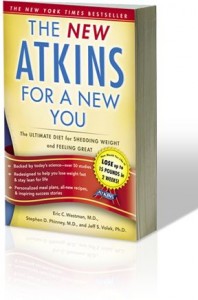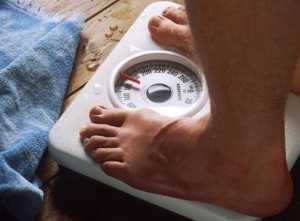Steve Phinney, what you think about the new study from Harvard/Boston Children’s Hospital about “A Calorie is not just a Calorie.”
STEVE PHINNEY: Well there is that (the concept that a Calorie is not just a Calorie). That’s what grabbed a lot of the news, and that’s a very important observation. People fed the same number of calories with very different composition of those calories, differing amounts fat and carbohydrate, in particular, had different effects on their metabolism. But to me the most important result of that study is that it has driven the figurative stake through the heart of the, “A low fat diet is good for you,” myth. That myth is now dead. All we have to do is bury it. Here’s the background. The Harvard researchers looked at three diets — there was a Mediterranean diet and what they called a low-carb diet ( and I’ll keep saying “their so-called” low carb diet . . . because it actually was not a very low carb diet) — then they had a high carbohydrate diet. And the people that they studied had metabolic syndrome characteristics, that is, things that you’d want to have get better. They were overweight, many had high blood pressure and/or high blood sugars and high levels of risk factors for heart disease. The bottom line? – Essentially very few of the research subjects got better on the low-fat high carbohydrate diet that’s so commonly recommended for weight maintenance and health. In contrast, a lot of the research subjects did get better on the Mediterranean diet, which was somewhat higher in fat and lower in carbs than the low-fat diet. But most of subjects got even better on the Harvard group’s so-called low carbohydrate diet. Now, both the Mediterranean diet and the low-carb group provided fewer carbs and more fat than the low-fat, high carb diet group ate. And both of these did better. So we can pretty much say goodbye to the low-fat myth, because if all the other studies in the past haven’t buried it yet, this one sure did.
You say the low-fat myth’s been buried, but I recently went to a pot luck dinner, and one chef told me that she made sure that her dish was low-fat, specifically saying ‘I was very careful to make this dish healthy. It’s low fat.’
STEVE PHINNEY: Even after you kill a giant you still have to dispose of the body… I’m not saying the body isn’t lying around messing up our kitchens, and you know the food industry does not change direction on a dime. But for those of us who do respond in a very healthy way to carbohydrate restriction, we will have more and better options for low-carb, high fat food choices.
Do you think this new Harvard study will influence school nutrition policy? Will it change the USDA “My Plate” diagram that emphasizes low fat, and lots of starchy carbs, for every child who eats school lunch?
STEVE PHINNEY: That’ll take a while, and what might help it change will be as people vote with their mouths. For instance, if there’s no butter on your plate and you want butter on your vegetables, you just bring it from home. It will keep. I have a squeeze bottle that I fill with butter and carry with me. It’s less than three and a half ounces, so if I’m heading to the airport, that squeeze bottle of fat gives me an extra ounce per day on a three-day trip, and I can get it through the airport as check on.
You believe this Harvard study might make it easier for people to be more open about eating low-carb/high-fat. But what do you think about the science . . . and the study’s impact on the press?
STEVE PHINNEY: Dr Cara Ebbeling was the first author, and that group at Harvard is a highly respected group. What’s more, getting it published in JAMA, the Journal of the American Medical Association, gives it considerable political clout. It is a very well designed study in terms of the basic science of it. But if I look back at why it turned out the way it did, it’s apparent that the low-carb diet that they used was an outdated version. It’s a version that they sort of took off the shelf, sometime between 2003 in 2006. Their study actually started in 2008, so naturally, they had to have designed the diet before the study started.
Unfortunately, 2006 is well before much of the recent research that has come out indicating the best way to formulate, or a better way to formulate, a low-carb diet. So scientifically speaking, the Harvard researchers were using a basically out-dated form of very low-carb diet that was too high in protein and too low in salt. What’s more, the amount of carbohydrate they fed was actually too high to quality as a very low-carb diet based on modern science. About the amount of carb — if you look at the Harvard group’s table where they describe their so-called low-carb diet, it looks like they fed each subject, basically 50 g of carbohydrate per day. But if you read the caption on the table, it shows that they actually fed each person 50 grams of carbohydrate per 2000 calories. Now 2000 sounds like a lot of calories for a person to eat, but in this study, the average subject got over 3000 calories a day. That means on average, each person got over 75 g of carbohydrate per day. For most people that much daily carbohydrate would prevent them from becoming fully adapted to the low-carb diet. That much carb is likely to prevent the healthy process that we have identified in published literature as keto adaptation.
You say that Harvard’s so-called “very low-carb, high-fat” diet was not very low carb because it averaged 75 g a day per person, rather than less than 50. You’re also concerned that they fed people too much protein.
STEVE PHINNEY: In the research article they state it was a very low-carb diet. In actuality it was not a very low-carb diet, and when you combine the 75 grams of carbohydrate a day with the fact that the typical subject was getting 225 g of protein per day, that would further interfere with adaptation to fat burning – that is, what we call keto-adaptation. You see, with 225 grams of protein, it means their so-called very low carb diet was actually a high protein diet. And it turns out that the combination of the high-protein and that substantial amount of carbohydrate would significantly interfere with the beneficial adaptations that we’ve shown with a truly low-carb diet. These are adaptations we call nutritional ketosis, where a body becomes efficient at burning fat for energy. We’ve shown that this nutritional ketosis is the most effective metabolic state for countering insulin resistance and turning around, basically putting either type II diabetes or metabolic syndrome, in remission. In the Harvard study, they undershot the effective, truly low carbohydrate diet by a very considerable degree.
Why would excess protein be a problem?
STEVE PHINNEY: A lot of people focus on what a low-carb diet does to insulin levels, and some people think it’s all about insulin levels. Some of us think beyond that, but just focusing on insulin levels per se, and the low carb diet . . . if you eat a low-carb diet, the lower consumption of carbs can indeed allow your insulin levels to go down. That’s helpful for improving insulin sensitivity. But if you also eat a lot of protein, then insulin levels will go back up because protein is an even greater stimulus of insulin production than are carbohydrates.
Do you mean that when you eat a steak, it causes insulin to rise in your bloodstream?
STEVE PHINNEY: If you eat a 16 ounce steak your insulin will rise much more than if you eat an 8 ounce steak with two pats of butter on top. With the 16-ounce, lean steak, the higher protein and lower fat will significantly raise your insulin and interfere with your adaptation to being a fat-burner. It will keep you more stuck on relying on carbohydrates to fuel your body. It will slow down your ability to burn fat in your body as its preferred fuel. So in the Harvard study, think of it this way. When you combine the 75 or so grams of carb the average test subject ate, plus all that 225 g of protein, which by the way, is at the upper limit of human tolerance and is twice what is probably optimum or necessary for a person on a low-carb diet, then between the carb that is already more than 50 g a day and the protein which will raise insulin on its own, and, by the way, generate more sugar formulation from the excess protein, all this together means that it’s not a well-formulated diet for ideal health and it does not qualify as a very low carb diet.
You’re calling it a “too much protein” diet. But the Harvard researchers say they based that diet on something most people would call very low carb. And that’s Atkins.
 STEVE PHINNEY: Yes they called it like an Atkins diet but it’s a caricature of our modern view of Atkins. As you’re aware, Shelley, Jeff Volek, Eric Westman and I published a book in 2010 called, The New Atkins for a New You, and for the first time in an Atkins book, we actually have a chapter on protein consumption. In that chapter, we identify, not precisely how much protein a person should eat, but we do give people a range. Let’s compare it to the Harvard Study, where the average height of their test subjects was five feet eight inches tall. In our book, we recommend for woman who are five feet eight inches tall at least 90 g of protein — but it could be only 90 g and still be healthy. Meanwhile, for men of that height we suggest 150 or 160 g of protein. So in our published recommendations, the range was 90 to 150 g, and that is what we consider is the widest range for a well formulated low-carb diet. In contrast, the Harvard study used 225 g, which is off the charts–way too much protein. Now is it brand-new information that this is too much protein? The answer is absolutely not because I did my PhD as a graduate student at MIT, collaborating with scientists at Harvard, and I defended my PhD dissertation in 1980. And the diet I used back then was the basis for this definition of what’s the ideal amount of protein. And my diet provided about 115 g of protein per day for males who averaged about 5 feet 9 inches tall. Back in 1980, we proved that just 115 g of protein a day was a very effective amount to preserve both their lean tissue content and their function. What’s more, as you recall, Shelley, back in 1980 five of my test subjects were highly trained bike racers. We pushed them to their max and proved that they lost no performance ability once they were totally adapted to a very low carb diet. But it wasn’t the “low-carb” diet used by the Harvard group in this recent study.
STEVE PHINNEY: Yes they called it like an Atkins diet but it’s a caricature of our modern view of Atkins. As you’re aware, Shelley, Jeff Volek, Eric Westman and I published a book in 2010 called, The New Atkins for a New You, and for the first time in an Atkins book, we actually have a chapter on protein consumption. In that chapter, we identify, not precisely how much protein a person should eat, but we do give people a range. Let’s compare it to the Harvard Study, where the average height of their test subjects was five feet eight inches tall. In our book, we recommend for woman who are five feet eight inches tall at least 90 g of protein — but it could be only 90 g and still be healthy. Meanwhile, for men of that height we suggest 150 or 160 g of protein. So in our published recommendations, the range was 90 to 150 g, and that is what we consider is the widest range for a well formulated low-carb diet. In contrast, the Harvard study used 225 g, which is off the charts–way too much protein. Now is it brand-new information that this is too much protein? The answer is absolutely not because I did my PhD as a graduate student at MIT, collaborating with scientists at Harvard, and I defended my PhD dissertation in 1980. And the diet I used back then was the basis for this definition of what’s the ideal amount of protein. And my diet provided about 115 g of protein per day for males who averaged about 5 feet 9 inches tall. Back in 1980, we proved that just 115 g of protein a day was a very effective amount to preserve both their lean tissue content and their function. What’s more, as you recall, Shelley, back in 1980 five of my test subjects were highly trained bike racers. We pushed them to their max and proved that they lost no performance ability once they were totally adapted to a very low carb diet. But it wasn’t the “low-carb” diet used by the Harvard group in this recent study.
So, you’re calling it a cartoon version of a truly scientifically based, very low carb diet?
STEVE PHINNEY: I would call it the Harvard caricature of Atkins. Yet, a lot of things got a lot better for test subjects eating the caricature diet, despite the fact there were flaws in their design of that dietary approach. However, two things that the Harvard researchers saw, which then got reported and overblown by the press, are that compared to the Mediterranean diet, the people on the Harvard caricature diet had a significant increase in cortisol levels. Cortisol is a stress hormone and they said, See? A low-carb diet causes stress.
Do you think it was the low-carb that caused increased cortisol on the Harvard “caricature of Atkins” diet, or was it the low levels of salt?
STEVE PHINNEY: It’s probably the salt. And this is an example of how a study can look really good on paper but can be kind of physiologically inappropriate in real life. You see, in the Harvard study, they compared three different diets. And for all three, they gave everybody on all three diets the exact same amount of salt. For over 30 years I and my collaborators have repeatedly pointed out that when you’re on a low-carb diet the body’s handling of salt changes. You need of bit more of it. So, when the Harvard researchers gave people a relatively low-carb diet that was also low in salt, the low salt actually stressed the circulatory system. You see, on a relatively low carb diet, unless you take in more salt, blood volume shrinks. The body then responds to this dehydrating by making more adrenalin and other stress hormones. Including raising cortisol. I would predict if they had given just one cup of something salty, such as natural chicken broth or bullion, in conjunction with their diet they would not have seen the high cortisol level. So it’s too bad that they didn’t do that. After all, if you can make the dehydration of a very low carb diet go away with a 10 cent bullion cube ,once a day, why should it even be an issue.
What about media’s report that C-Reactive Protein levels weren’t as good on the so-called low carb diet?
STEVE PHINNEY: In the press at least, another deficit in their “caricature of Atkins” diet was that they noted that C reactive protein was higher than it was on their Mediterranean style diet. Now, C-Reactive protein is on of many measures of the body’s inflammation. And a wide range of other inflammatory markers went down the most on the low-carb diet.
But even if we simply focus on CRP . . . In their study, C-Reactive protein was, indeed, a little bit higher on their caricature diet, than it was on the other two diets. When you step back a bit, it’s worthwhile to know that study was done in people who started out being quite obese. Before they put the study participants into the three different, maintenance diets, the researchers first put all these obese participants on a limited calorie diet and had them lose about 12% of their body weight. So someone who weighed 100 kg and lost 12 kg lost some weight. AFTER they had lost that weight, they then had partipants do one of the three diets, and then the other and then the other in sequence. So that’s the big picture of how the diet test was conducted.
As for C-Reactive protein, after the weight-loss part of the study, the average participant started out at a level of 1.6 for CRP, which is not a good number. The average participant dropped down to about .9 on the other two diets in the study — the high carb, low-fat, and the Mediterranean Diet. Their CRP level also dropped on the “caricature of Atkins” diet. To about 1 for the CRP. That’s about 85% of the improvement that you got with the other two diets. This was often reported to the press as if low-carb diet made CRP levels go up. That’s not true. It’s just that CRP didn’t go down quite so much on the Harvard “caricature of Atkins” diet.
Furthermore, when we do studies with a well formulated ketogenic diet that has less than 50 grams of carbs a day and far fewer grams of protein than the Harvard researchers used, then we invariably, in study after study, see biomarkers of inflammation go down more compared to a carbohydrate containing diet. So my guess is that the Harvard group saw much of the benefit of low carb, even in their “caricature of Atkins” diet. But they would have seen a lot more lowering in inflammation if they got the diet right. But they didn’t get the diet right and so they can’t point fingers at all low-carb diets.
What happened to other inflammatory markers that were measured in the Harvard Study?
STEVE PHINNEY: I’m sure they measured many, though they only reported some of them. One inflammatory marker they did mention is plasminogen activator inhibitor, also known as i PAI-1 . It may be a more potent biomarker of risk than is CRP. PAI-1 went down more on their pretty good low-carb diet compared to the other diets, so you might say CRP didn’t go down as much on a sort-of low carb diet. But there’s another inflammatory marker that may be as important or more important, and it went down more. However, we didn’t hear about PAI-1 in the press.
What about insulin resistance and markers such as triglycerides?
STEVE PHINNEY: Insulin sensitivity improved to a greater degree on the Harvard “pretty good” low carb diet than it did on either of the other two dies. Also, their so-called low carb let do significantly greater drops in serum triglycerides. Plus the so-called good cholesterol HDL cholesterol went up more on their low-carb die.
What about their resting metabolism?
STEVE PHINNEY: The resting metabolism of study participants stayed stable on the low-carb diet, and in the low-fat group and in the Mediterranean diet group, resting metabolism went down. This means the pretty good low-carb diet group could burn more calories and hold their weight more stable, which meant they could eat more food and still stay stable, which predicts that they would be much better at maintaining their weight loss if they stayed on a low-carb diet longterm.
What’s the bottom line?
STEVE PHINNEY: There are many things in this study, when you examine the data, that strongly support the safety and efficacy of a low-carb diet, plus the long-term sustainability of even their version of the low-carb diet . And their results would have been even better with some modest tweakings based on modern data about a truly low-carb, adequate protein, high fat diet. Humans have been dealing with low-carb intakes for millions of years, and it works.








5 comments for “Steve Phinney: A Calorie is Not Just a Calorie”